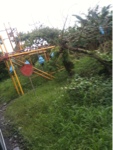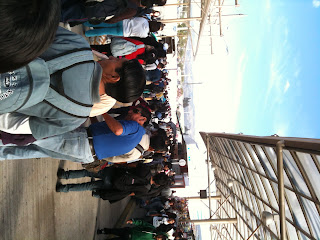 |
| Border Crossing: Nicaragua to Honduras |
 |
| Immigration Office at the Fishermen Market, Puerto Cortes, Honduras |
We kept asking him if we need a visa to enter your country, how come we were already inside. We showed him the tax we paid when we entered Hondorus and told him he should check with his colleagues on the other side of the border instead. He made some calls and insisted that we need to pay US$30 each before leaving the country, otherwise, he will retrieve our passport and put us to jail! (this country don't have justice and order and will put people to jail right away!? -probably yes, they don't!)
Well, any country has the right to interpret and change their entry requirements, we have no choice but pay.
We are requested to photocopy our passport and the entrance form page (where on hell is the photocopier in the fish market?) but he asked the ferry staff to do that for us, no charge. We just waited in the office. Fine, as long as the boat was going to wait for us.
Then we asked for a receipt, the officer said we need to go to the bank to pay to get a receipt, we asked where, he said downtown, which is 20mins away! (and the boat is leaving any time!) We kept bugging him as said, if we pay here, we should get a receipt! Then he said they could only issue receipt in downtown office if we insist. (Now what, Mister? Bank or office?)
Anyhow, he knew our boat was leaving any time and he gave every dumb reason in the world for not giving a receipt - that we all know why.
Well, we have no choice but to pay US$60 and the money went to the safest place right away - his shirt pocket.
 |
| Off we go, on a boat to Belize City |
Then, we were set free!
Anyway, we are safe and sound now.



























































